Sandy Bridge Memory Scaling: Choosing the Best DDR3
by Jared Bell on July 25, 2011 1:55 AM ESTMemory Scaling with Overclocking
What happens when we increase the CPU clock speed on our Core i7-2600K from the default 3.5GHz to 4.8GHz; how will that affect memory performance? To find out, I ran the memory bandwidth tests again comparing DDR3-1333 CL9, DDR3-1600 CL9, and DDR3-2133 CL9 at both 3.5GHz and 4.8GHz CPU clock speeds. I also ran the most bandwidth intensive real-world test along with the least bandwidth intensive real-world test at the overclocked CPU speed to see if the faster CPU clock speed made any difference here as well.
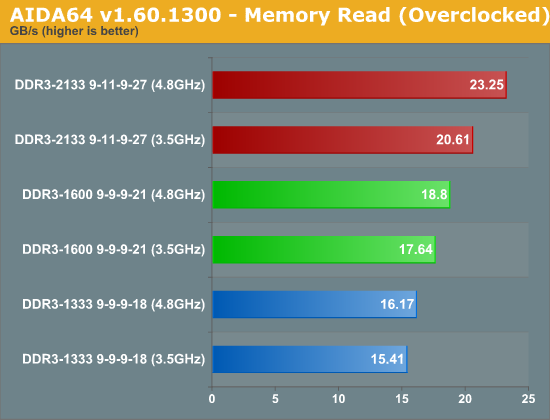
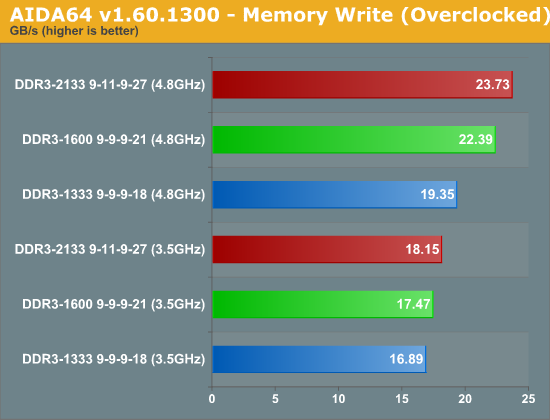
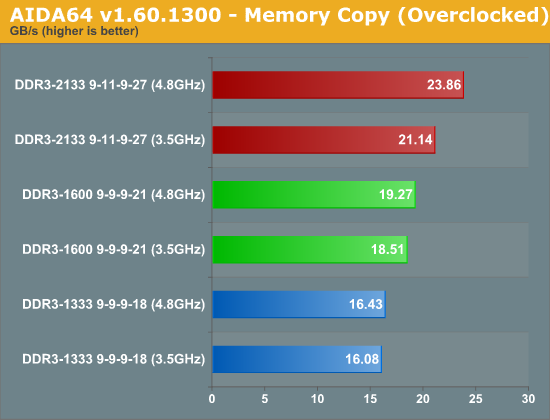
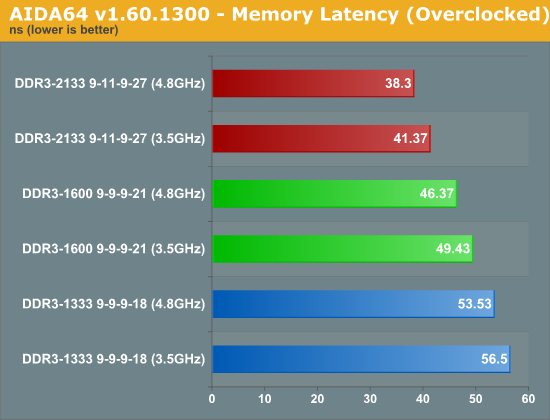
The AIDA64 memory benchmark shows that memory bandwidth does scale with CPU clock speed. Going from DDR3-1333 to DDR3-1600 showed a 14% boost on our stock CPU while showing a 16% boost on our overclocked CPU. Stepping up from DDR3-1333 to DDR3-2133 saw a 33% increase on the stock CPU and a 43% increase on our overclocked CPU. The copy and latency tests showed similar results. What's more impressive is that the write test showed a much larger 15% increase from DDR3-1333 to DDR3-1600 on the overclocked CPU compared to 3% on the stock CPU. Going from DDR3-1333 to DDR3-2133 increased write performance by 22% when overclocked compared to 7% when stock. While it's interesting to see how an overclocked CPU affects raw memory bandwidth, I'm much more interested to see how it affects our real-world benchmarks.
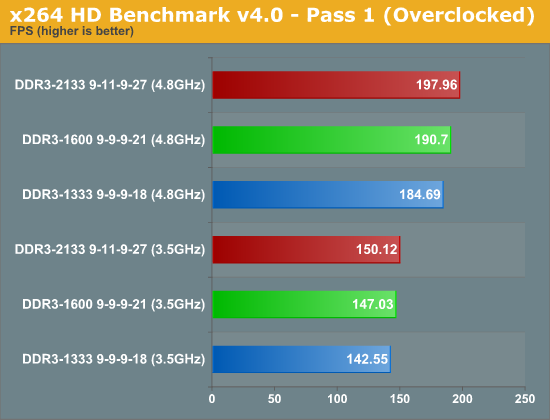

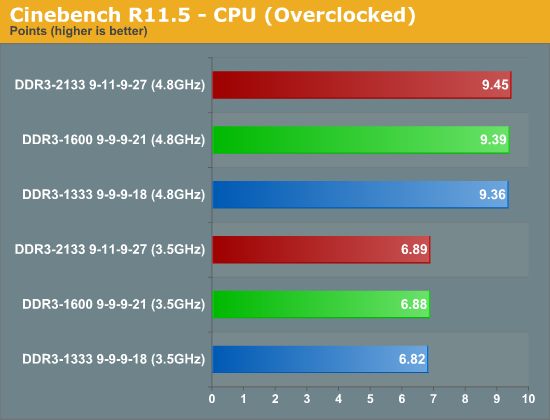
The extra bandwidth gained with the overclocked CPU doesn't exactly translate into much. The first pass of the x264 test reveals a 7% advantage for DDR3-2133 over DDR3-1333 on our overclocked CPU while the stock CPU shows a 5% increase. The increase for DDR3-1600 over DDR3-1333 is 3% for both our overclocked and stock CPUs. Once we move on to the second pass, there's no discernible advantage for faster memory on our overclocked system. The Cinebench test results are every bit as unimpressive with overclocking as at stock: overclocked or not, faster memory makes no real difference (though the faster CPU clock speed definitely helps a lot).










76 Comments
View All Comments
Rick83 - Monday, July 25, 2011 - link
Fancy heat spreaders are the worst that has ever happened to RAM.It gets worse when you have to pay more to get rid of it, as with the new low profile vengeance series from corsair.
Memory doesn't usually get that hot anyway, and the large heat spreaders impede airflow between the modules in fully populated setups, as well as limit what size your cooler can be, occasionally forcing you to get one of those water-cooler-in-a-box things which incur massive extra costs.
The only reason I don't want to have completely naked memory, is that the heat spreader gives the RAM some ESD protection, which is actually useful.
JoJoman88 - Monday, July 25, 2011 - link
The review just made your post the truest of them all jabber!Spacecomber - Monday, July 25, 2011 - link
In the past, one reason to get faster rated memory is that you eventually would see a migration of what was the standard memory module to something running on a faster bus speed. I'm not sure if that really holds true, anymore. It seems that these days you are more likely to see the adoption of a completely new type of memory, rather than an existing standard sticking around long enough for the minimum required memory speeds it is based on to go up.geofelt - Monday, July 25, 2011 - link
One of the price differentiators is the heat spreaders.Apart from the aesthetics, where is the value of fancy heat spreaders? Can it be measured?
Seems to me that they are mostly marketing gimmicks, excepting perhaps for those used on overclocking competitions.
I would like to see some sort of a study to determine the value of heat spreaders.
MrSpadge - Wednesday, July 27, 2011 - link
Short answer: nothing.MrS
BobDavid - Monday, July 25, 2011 - link
see subjectJarredWalton - Monday, July 25, 2011 - link
See the conclusion; we already did a look at that (with HD 3000 and Llano).http://www.anandtech.com/show/4476/amd-a83850-revi...
LoneWolf15 - Monday, July 25, 2011 - link
Ivy Bridge will be out next year. There is a reasonable chance it could have a bump in memory bandwidth. Buy RAM at one or two multipliers above what you need now, and when the upgrade comes along, you won't be wishing for new RAM.DDR3 is so cheap right now, it's worth planning ahead.
dman - Monday, July 25, 2011 - link
I've been looking for a review like this for a while, was a good read even if it didn't come as a huge surprise. I'm definitely interested in the AMD platform results if/when those are available.SteveSweetz - Monday, July 25, 2011 - link
I was disappointed to see this article lacked the detail (and quantity) of the gaming tests versus it's predecessor on AnandTech: http://www.anandtech.com/show/2792/10That article showed that memory frequency and latency changes had a greater impact in some games than others, and that in most cases the memory also had a greater impact on the minimum framerate (an important consideration) than average framerate.
Also disappointing to see no CAS6 sticks tested here. Particularly because 2GB 1600MHz CAS6 were relatively common at one point, but now, for whatever reason, G.Skill is the only company that still makes them. It'd be interesting to see if that's a meaningful exclusive. The previous article showed CAS latency being more important than frequency in some cases.